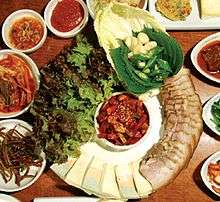Bossam
Bossam (보쌈, 褓-) is a pork dish in Korean cuisine. It usually consists of pork shoulder that is boiled in spices and thinly sliced.[1] The meat is served with side dishes such as spicy radish salad, sliced raw garlic, ssamjang (wrap sauce), saeu-jeot (salted shrimp), kimchi, and ssam (wrap) vegetables such as lettuce, kkaennip (perilla leaves), and inner leaves of a napa cabbage.[2][3]
 | |
| Place of origin | Korea |
|---|---|
| Associated national cuisine | Korean cuisine |
| Main ingredients | Pork shoulder, belly, or hand |
| Korean name | |
| Hangul | 보쌈 |
|---|---|
| Hanja | 褓- |
| Revised Romanization | bossam |
| McCune–Reischauer | possam |
| IPA | [po.s͈am] |
Bossam is a popular dish in South Korea, often served as anju (i.e. food accompanying alcoholic drinks).[4] To eat, the meat and side dishes are wrapped together in ssam vegetables, hence the literal meaning of bossam: "wrapped" or "packaged".
History
Bossam is traditionally linked with the process of gimjang, during which large quantities of kimchi are prepared for winters.[5] To ensure the commitment of the workers during this labor-intensive process, yangban (scholar-gentry of the Joseon era) would deliver a pig for a feast.[5] The workers would enjoy boiled pork with some of their newly made kimchi, which, being early in the fermentation process, was a fresh and crispy complement to the soft pork of bossam.[5]
Preparation
Although beef can also be used, pork is preferred for bossam.[6] Pork shoulder is the most commonly used cut, but fattier cuts such as pork belly and chewier cuts such as pork hand can also be used.[6] The meat is tied with kitchen twine to hold its shape, and boiled in a broth that contains star anise, ginger, white part and root of scallion, garlic, doenjang (soybean paste), coffee powder, tea leaves, and so on, to reduce the gaminess.[6] When cooked, it is rinsed with cold water, untied, and pressed lightly in a cotton cloth to maintain its shape.[6] When cooled, the meat is sliced into pieces of about 0.3 centimetres (0.12 in) and served with varieties of side dishes, typically including spicy radish salad similar to the kimchi filling, inner leaves of napa cabbages, and freshly made baechu-kimchi (napa cabbage kimchi).[6]
If the meat is served with fresh raw oyster, the dish is called gul-bossam (굴보쌈; "oyster bossam").[5]
Gallery
.jpg) Bossam
Bossam.jpg) Gul-bossam (bossam with oysters)
Gul-bossam (bossam with oysters) Bossam table with banchan (side dishes)
Bossam table with banchan (side dishes)
References
- Sifton, Sam (12 January 2012). "The Bo Ssam Miracle". The New York Times. Retrieved 5 April 2013.
- "bossam" 보쌈. Korean Food Foundation (in Korean). Retrieved 27 May 2017.
- Jung, Alex (11 November 2011). "5 Korean ways to eat a pig". CNN. Retrieved 11 April 2012.
- Lee, Cecilia Hae-Jin (29 April 2015). "Koreatown's Mr. Bossam serves bossam -- and spicy ribs with cheesy corn". Los Angeles Times. Retrieved 27 May 2017.
- "Jongno 3(sam)-ga`s Gul Bossam Alley". Visit Seoul. Seoul Metropolitan Government. 28 November 2011. Retrieved 16 April 2013.
- "bossam" 보쌈. Doopedia (in Korean). Doosan Corporation. Retrieved 27 May 2017.
External links
